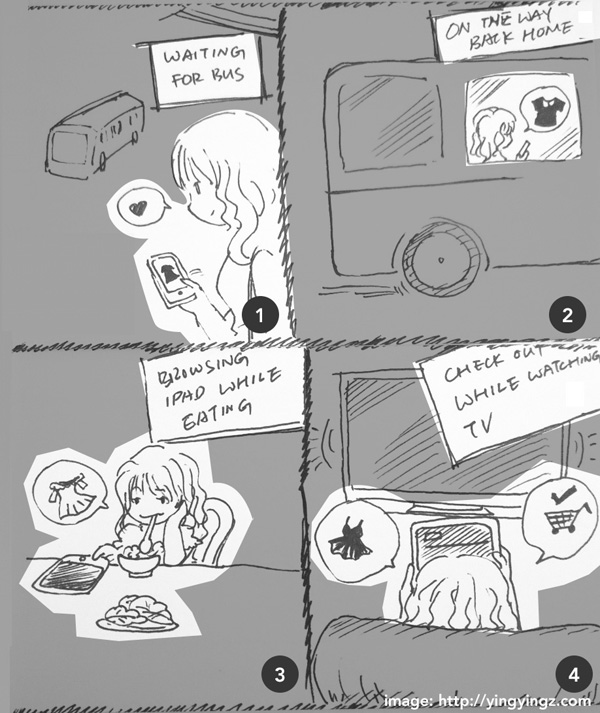Michal Levin gave a great talk on designing multi-device experiences at the SF Mobile UX meetup. Check out her new book: Designing Multi-Device Experiences. There’s also a webcast available if you are interested.
My take-aways, along with notes from the talk are as follows:
There has been an amazing growth of smart device users and app downloads, according to Michal, there will be:
- 1.75 billion smartphone users worldwide 2014
- 24 billion wireless connected devices in 2020
- 225 billion app downloads in 2016
Nowadays, it has become essential that devices communicate with, connect with and share data with each other.
Picture this:
Emily was browsing her phone to find a new dress while waiting at the bus station; the bus came, she got onto the bus and continued her search. After she got back home, Emily continued her search on iPad while she was eating dinner, and then hopped onto the sofa to watch her favorite TV show. She made a purchase while while watching TV.

That’s right, your customers do not live in a single-device environment any more.
Michal talked about the core family in the device ecosystem: smart phone, tablet, PC and TV. Such ecosystem has three key characteristics:
- Consistent
- Continuous
- Complementary
Consistent:
Examples: Google.com, Trulia and Hulu Plus
You need to provide a consistent experience for your customers. You may replicate experience across different devices, such as having the same content, flow, structure and core feature set across phones, tablet and PC; but remember to adjust them to accommodate different screen sizes and other device-specific properties.
It’s great to keep experience consistent, but keep these in mind:
- Context is the most important: we need the right thing at the right time, at the right place. Think about when and why your customers use this device, what value you’re provide, how you can really help them.
- Relationship: every device can complement with each other, they’re not alone.
- Decide which device is available to provide the best experience and can be considered, and which should be abandoned.
- Make the experience scalable, think about how it may work in the future, think about IoT (Internet of Things).
Continuous
Examples: Chromecast, Allrecipes, and bookmarks for Amazon Kindle / Audible
Nowadays, experience is shifted between devices. It can be continuation of the same action, or progressing along a sequence of actions. In the first example, Emily was browsing dresses on her phone at the bus station; she continued browsing and made a purchase on iPad after she got back home.
Another example is Tesco virtual supermarket. It’s a virtual item catalog on the wall, right out of subway. A customer can browse items on catalog (physical world), scan the QR code with your phone (virtual world), and your goods will be delivered at home (now you’re back to the physical world). It’s an interesting experience: it’s there for people who just walk out of the subway, and want something quick and small; it’s interactive and fun.
Michal let us imagine that in the future, you save a shopping list on the phone. After shopping, you put groceries into the fridge. Your phone is connected to the fridge, and then the smart fridge notifies your phone if the eggs are running out, then on your shopping lists, it’s time to buy more eggs :)
Complementary
Examples: Real Racing 2, KL Dartboard, Nest
You devices can be complementary to each other, or control other devices. For example, you pick a TV show on your phone, then connect it to the TV, and now you can the phone as the remote control. If multiple iPhone users play Real Racing 2 together, it then becomes a multi-player game, with the phones becoming game controllers. Second Screen is another concept under this topic.
Keeping these three characteristics in mind – Consistent, Continuous and Complementary – is important. The most important thing is to figure out the end to end context, customer journey, and know what story you’re trying to tell; then you break it down into pieces and design for each device, while figuring out which device is the best to support certain features. Device size matters, but it’s never just about the size.
Finally, Michal said, figuring out the vision, think big even if you start small.
推荐一下自己之前写的一篇《跨终端设计模式》,嘿嘿!
哈哈,谢谢评论,我去看看